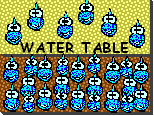

|
Rivers? Streams? Creeks? They are all names for water flowing on the
Earth's surface. As far as the Water Science site is concerned, they
are pretty much interchangeable. I tend to think of creeks as the
smallest of the three, with streams being in the middle, and rivers
being the largest.
What is a river?A river is nothing more than surface water
|
Where does the water come from? |

|
The water in a river doesn't all come from surface runoff. Rain
falling on the land also seeps into the earth to form
ground water. At a certain depth below
the land surface, called the water table
|
| Look at the diagram below. The earth below the water table, the aquifer (the purple area), is saturated, whereas the earth above (the pink area) is not. The top layer (unsaturated soil/rock material) is usually wet, but not totally saturated. Saturated, water-bearing materials often exist in horizontal layers beneath the land surface. Since rivers, in time, may cut vertically into the ground as they flow (as the river cuts into the purple section in the diagram), the water-bearing layers of rock can become exposed on the river banks. Thus, some of the water in rivers is attributed to flow coming out of the banks. This is why even during droughts there is usually some water in streams. |

Rivers and the landscape
![]() Rivers and sediment
Rivers and sediment
![]() River lengths
River lengths
![]() Surf your watershed (EPA)
Surf your watershed (EPA)
|
Earth's water
The URL for this page is http://ga.water.usgs.gov/edu/earthrivers.html Comments? Contact Howard Perlman Last Modified: May 28, 2003 |
|